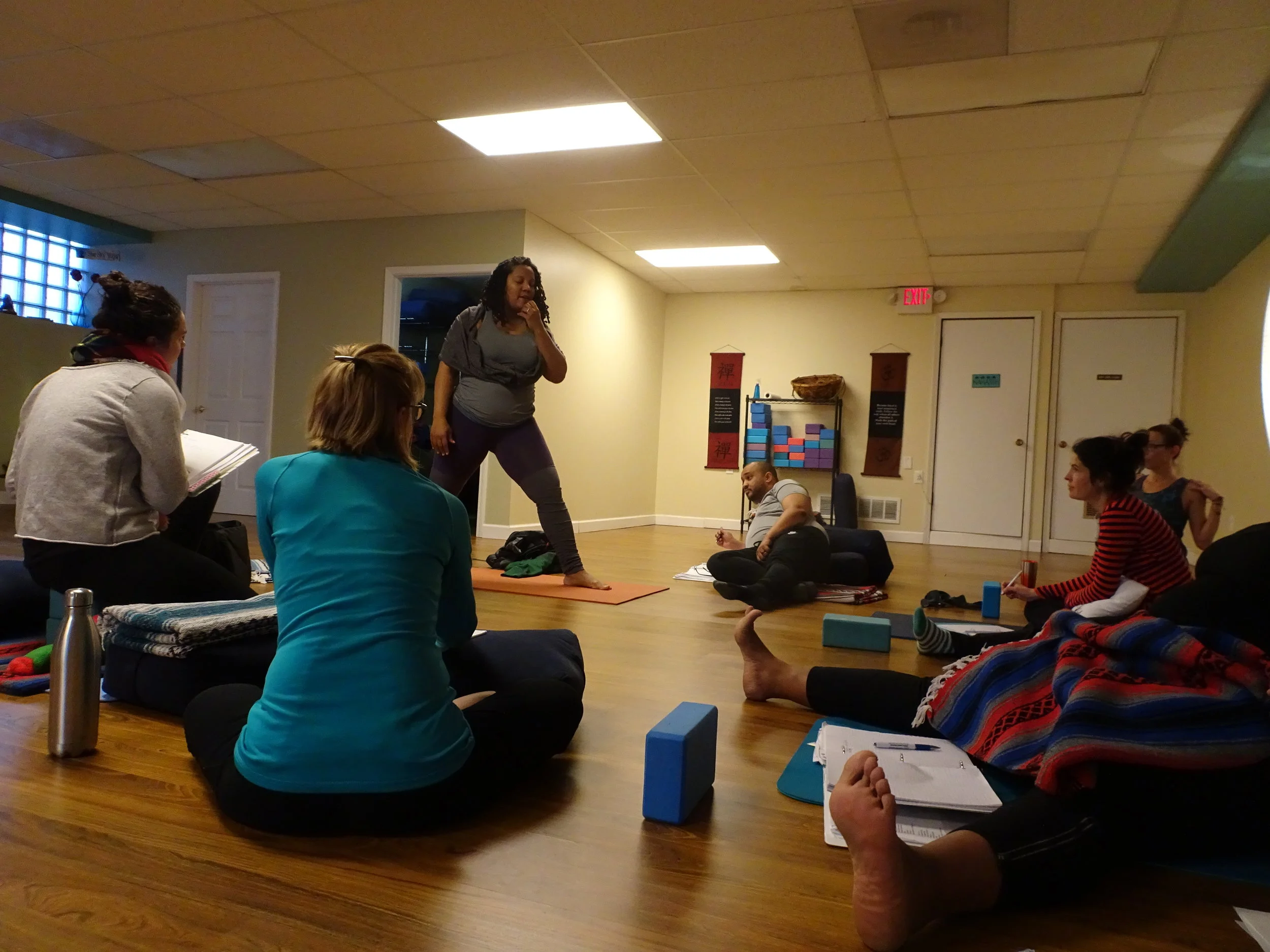Blue Sky Yoga teacher and founder of Yoga Pipeline Stacy Berry and Blue Sky Yoga teacher Liz Giordano recently sat down for a conversation around yoga and social activism.
Yoga off the mat: the Yamas & the Niyamas
We all begin a yoga practice from a different place in our lives. In the beginning, many of us are seeking the development of our physical selves. With time, we learn that yoga is much more than postures, and we often find ourselves questioning our patterns and beliefs on and off the mat. This process can be uncomfortable, as we develop a new sense of awareness about how we interact with the world. This is how we begin to understand that our yoga and the way we move in the world are inseparable.
The yoga tradition is rooted in the philosophy and practice of the Yoga Sutras as written by Patanjali. The Yoga Sutras outline the Eight Limbed Path that leads to enlightenment and liberation. The first two limbs are the Yamas (restraints) and the Niyamas (observances). As Michelle Cassandra Johnson writes in her book Skill in Action, “The Yamas and Niyamas offer a framework for how to create a just world” (19). The Yamas begin with non-harming (ahimsa), truthfulness (satya), non-stealing (asteya), moderation of the senses (brahmacharya), and non-grasping (aparigraha). The Niyamas are cleanliness (saucha), contentment (santosha), discipline (tapas), self-study (svadhyaya), and devotion to a higher power (ishvara pranidhana). The yamas and niyamas are guideposts, providing a moral foundation to our practice. If we consider our behavior through the lens of the yamas and niyamas, our interactions with others become part of our yoga practice.
When we start to approach the world in this way, social activism becomes a natural extension of our yoga practice. One of the most pressing issues of our time is racial equity. How does our yoga practice help us in approaching issues that are complex and difficult? We begin from a desire for understanding and for dialogue. We begin with a curiosity of how to undo the harm that racism has caused. We begin by believing that we CAN rise to the occasion of this difficult work. We begin by speaking, even if our voices shake. And only then can we begin to consider how we have all been unintentionally contributing to a racist system.
“The individuals and the collective have to be willing to make mistakes and learn from them along the way. This is messy work, be willing to make a mess” ~Michelle Cassandra Johnson
A problem so big as racism can be daunting; we simply don’t know where to begin. There is a temptation to ignore the problems of racial inequity or to avoid them altogether. But our yoga holds us to a higher standard. We have to be willing to begin this work, even if it means making mistakes along the way. Johnson writes, “The individuals and the collective have to be willing to make mistakes and learn from them along the way. This is messy work, be willing to make a mess (46).”
The practice of yoga & our responsibility to others
We, as students of yoga, also have a responsibility to be compassionate toward others along this path in keeping with the yoga tradition. “This work shouldn’t be shame-based. We need to call one another up instead of calling each other out. Instead of shaming people, we want to lift them up. We don’t want people to shut off, or disengage,” explains yoga teacher and founder of Yoga Pipeline Stacy Berry. “I want people to feel safe to say anything without fearing that they will be shamed or judged. People are afraid to have these conversations for fear of revealing where they fall short.”
Yoga also helps us to cultivate awareness of our actions and our thoughts. We can direct this energy into work with social justice. As Berry put it, “It’s about heightening our awareness. Encourage conversation, and be aware of how our actions affect others.”
We can use this increased awareness to shift our perspective and as a basis for action. As yogis, we can begin to ask ourselves certain questions, like, “Who is in the room? Who benefits from this practice, and who is left out? How can my studio become more welcoming to people of color, or people of other marginalized communities?”
What can we do right now?
This subject can be so daunting that many of us don’t know where to begin. A few ideas for action might include:
Meet yourself where you are; find other white, cisgender yogis doing this work and seek their guidance.
Seek out yogis of color and people of color on social media and listening, reading, and compassionately hearing their perspective.
Make it a point to listen with an open mind to people of color who share their experiences, and listen for understanding, rather than to respond.
Consider that there is a difference between our intentions, which we might believe innocent, and the impact of our words and actions. Impact is always greater than intention.
Find local groups that help to explore questions of race and implicit bias, like Witnessing Whiteness. Also consider non-local groups like The Red Boot Way (www.theredbootway.org) founded by Molly Barker (also the founder of Girls On The Run).
Study with yoga teachers of color.
Learn more about the philosophy of Yoga via the Yoga Sutras and The Bhagavad Gita.
For further reading:
Skill in Action: Radicalizing Your Yoga Practice to Create a Just World, Michelle Cassandra Johnson,
Radical Dharma: Talking Race, Love, and Liberation, Jasmine Syedullah, Lama Rod Owens, Angel Kyodo Williams.
Witnessing Whiteness, Shelly Tochluk
White Fragility: Why it’s so hard for white people to talk about racism, Robin DiAngelo.
The Yamas & Niyamas Deborah Adele
You can find Stacy on Instagram at @evolutionyogastl and Liz on Instagram at @lizallengyoga

